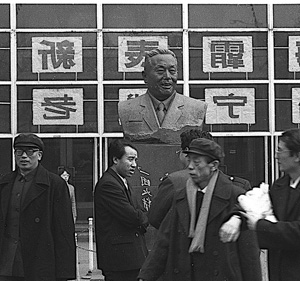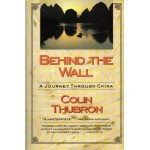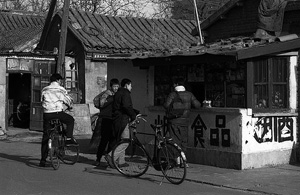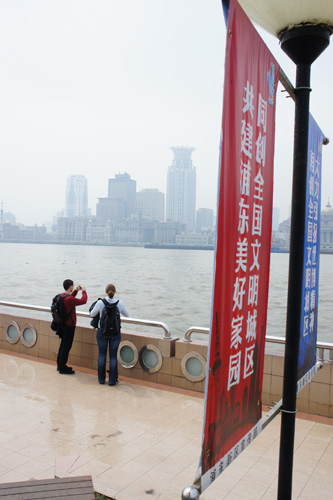Behind the Wall: A Journey Through China by Colin Thubron (1987).
 The modern skyscrapers of China tell us no stories. They are evidence that China has arrived and that China has modernized, but they tell no stories about the journey it took to get to this point. Behind the Wall: is a traveler’s journey through mid-1980’s China (before Shanghai looked like Chicago on steroids). Backpackers to Beijing laid around in their hostel rooms complaining of how awful the country was and how difficult it was to travel there. The 30-something story luxury Jinling Hotel in Nanjing was the tallest building in China.
The modern skyscrapers of China tell us no stories. They are evidence that China has arrived and that China has modernized, but they tell no stories about the journey it took to get to this point. Behind the Wall: is a traveler’s journey through mid-1980’s China (before Shanghai looked like Chicago on steroids). Backpackers to Beijing laid around in their hostel rooms complaining of how awful the country was and how difficult it was to travel there. The 30-something story luxury Jinling Hotel in Nanjing was the tallest building in China.
In the rest of the country, rats ran through dumpy guesthouses. The streets were not clogged with cars. Museums were few and far between. Trips had to be taken with introductions and a true sense of adventure, with peasant-packed traincars, the floor covered with spittle and sleeping bodies. Diners could eat cat or dog or even worse. Thubron is among the most gifted travel writers in expressing these experiences with the written word, and they are gloriously free of cliché.
 In this China, the division between foreign tourist and local was vast, with separate hotels, restaurants, and stores where shoppers needed foreign exchange coupons to shop. Returning family members from overseas would gift their Chinese relatives with these coupons, which would open new worlds to them.
In this China, the division between foreign tourist and local was vast, with separate hotels, restaurants, and stores where shoppers needed foreign exchange coupons to shop. Returning family members from overseas would gift their Chinese relatives with these coupons, which would open new worlds to them.
The true value to this book is that the author spoke Mandarin. It is difficult to imagine a writer who didn’t speak Chinese taking this journey. There would be no conversations with locals, no invitations into homes. There would just be observations. Likewise, a journey taken by a Chinese traveler would be limited by the shared cultural background, which would not open them up to discovery from our Western eyes. For us to comprehend true tales of travel, we require an outside lens, yet knowledge of the local language.
 He encounters Chinese who have never spoken to a foreigner. He meets many, young and old, for whom England was a mythic place. It may as well have been the Moon to the peasants he encountered on busses and trains, except that they all knew where the Moon was. Any land beyond China was not just foreign, but unheard-of. Where was England? What was it like? How much did things cost there?
He encounters Chinese who have never spoken to a foreigner. He meets many, young and old, for whom England was a mythic place. It may as well have been the Moon to the peasants he encountered on busses and trains, except that they all knew where the Moon was. Any land beyond China was not just foreign, but unheard-of. Where was England? What was it like? How much did things cost there?
Throughout his travels, Thubron seems overly obsessed with the impact of the Cultural Revolution on the Chinese people, but after reading the book, I share the same fascination. In such a recent era, how were millions beaten, killed, exiled in a xenophobic war on anything intellectual, historic, or traditional? This was the era from 1966 to 1976, when the Red Guard took to the streets to destroy everything non-Communist and bourgeois. Thubron tells tales of a time when music students smashed the pianos at their conservatories, youth destroyed statues in Buddhist temples, professors were sent to labor in the hinterlands, others were beaten by government-encouraged gangs, thousands (millions?) killed. Throughout the book, Thubron asks people what they did during the Cultural Revolution, how they reacted, and how they feel about it now. This fills the book with sorrowful tales, but it adds a depth to the book that today’s traveler would not experience.
This unique moment, a dozen years beyond the Cultural Revolution and a dozen years before China began to affect world commerce, provides a bridge for the contemporary reader, and Thubron was lucky enough to see the seeds of change. Older residents told him the youth was changing. They could not remember the great famines or the revolutions. They want things. They want to think for themselves. Many predicted change in the air (as if change is not always in the air), and we can see how this led to the China of today.
But no one accurately predicted today’s China. The separation of wealth is still vast, and the have-nots still have not. However, the haves are growing, and the poverty evident in the mid 1980s is not evident today. Today, there are still peasants, and a voyage through the deep countryside could still uncover similar revelations. Those who only know the Shanghai of the business district and the Beijing of package tours will benefit the most from Behind the Wall. Thubron did not discover today’s China, but somehow his insight explains how it happened.
More Travel Book Reviews from Global Postmark
A book review by Matthew Stone of Behind the Wall: A Journey Through China by Colin Thubron (1987), one of the best travel books of all time.


sounds like a great book, I’ll have to check it out.